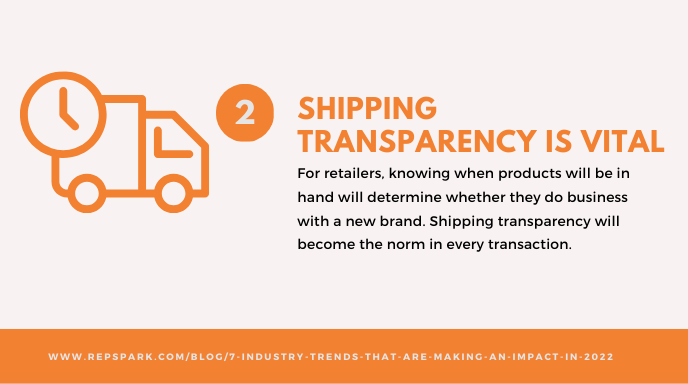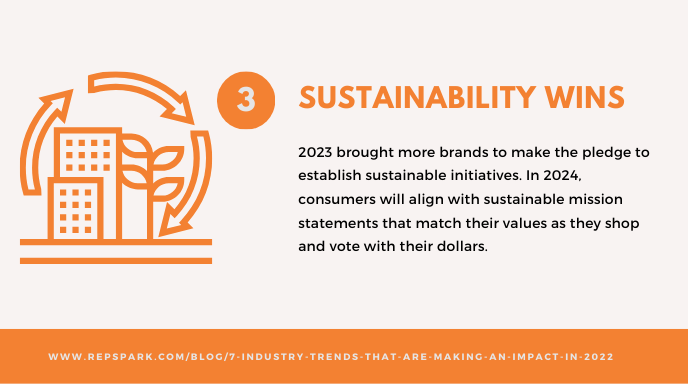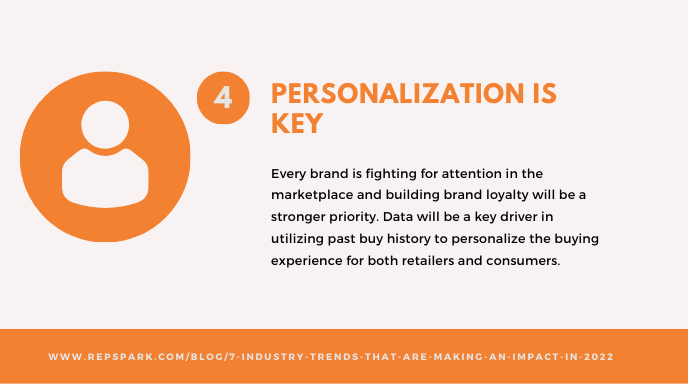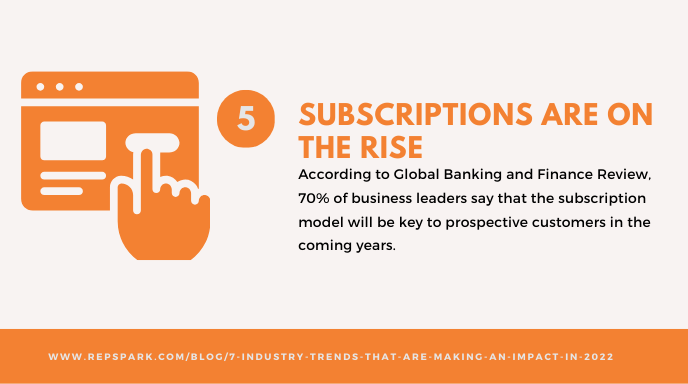Share this
7 Industry Trends That Are Making An Impact in 2024
by Susan Gonzalez on January 13, 2022
Here is a list of the top 7 buying and selling trends to expect in 2024, including infographics, strategies, and ideas on how your brand can execute. In a world of constant change and adjusting to new norms, it can be challenging to plan ahead. However, taking a moment to look into trend forecasts is crucial in setting your brand up for success in the marketplace.
To help set your brand up for success, we’ve looked ahead to 2024 and compiled a list of the top trends to expect. Not only are we reporting these trends, but we’ve also included strategy ideas along the way of how your brand can be executed. Cheers to your success!

1. Hyper-Personalization

One of the methods to stay ahead of competitors in 2024 is to embrace hyper-personalization of offers and customer interaction. Already in 2023, personalization was an integral part of online sales. In 2024, customers increasingly expect brands to interact with them based on their specific preferences. The era of a generic, one-size-fits-all approach is giving way to strategies finely tailored to individual needs.
In 2024, this hyper-personalization trend will become even more central to customer experience initiatives. Leveraging sophisticated data analytics, artificial intelligence (AI) to collect and interpret customer data will be essential for businesses.
Also, loyalty programs offering rewards and personalized experiences can drive customer retention and improve lifetime value.
How your brand can implement this trend:
Enable automation for your brand and create custom digital catalogs for all your buyers. Just because the market demands an “always-on” appearance doesn't mean that you actually need to be. By creating a universal preview template, you can showcase your brand's collection to prospective buyers and allow them to view it immediately when ready. With RepSpark’s B2B software tool, customers are also able to track orders and invoices immediately and place orders against live inventory 24/7.
2. Cybersecurity Becomes Essential

In 2024, cyber security is no longer an option but an essential that must be implemented. We talk very regularly about cyber security, but in reality, very few companies really do what is necessary to protect their website. Only the largest companies invest heavily in preventing attacks, so small and medium-sized businesses are most often targeted.
Strong cybersecurity practices instill trust and confidence in customers, assuring them that their information is secure and encouraging repeat business and loyalty.
How your brand can implement this trend:
Concretely, how can you avoid getting hacked? One simplest and most effective way to protect yourself is updating your CMS and its extensions. The vast majority of sites that are hacked are not up to date.
Beyond that, you can call on an expert to carry out an audit of your website to detect problems or carry out a pentest (penetration test) where specialists will try to attack the website without causing damage and warning you if it succeeds.
3. Generalization Of Virtual Fitting (VR)

Virtual try-on allows customers to view products, often in 3D, as if they had purchased them. It is a remote fitting, which allows you to enormously increase conversion and minimize product returns.
Technologies such as augmented reality and virtual reality are taking customer engagement to the next level by providing more immersive and interactive experiences than ever before. Video content is also gaining ground, helping brands tell their stories more effectively and engage consumers as part of a multi-layered multimedia experience.
Until recently, the use of virtual reality (VR) and augmented reality (AR) in online stores were exceptions. Gadgets implemented by major brands in marketing operations and not or barely accessible to online sales companies.
This has started to change and will continue to evolve in 2024: for example, Google has implemented a 100% online try-on feature. This virtual fitting is at the crossroads of hyper-personalization and self-service. Apart from 100% virtual with VR/AR fitting, we are also seeing new hybrid solutions that forge the link between online shops and physical stores. In stores, more than 80% of customers use their mobile phones to compare and find out about what they are buying. In the other direction, for example, the Chinese company Shein regularly launches pop-up stores in Paris or Lille.
How your brand can implement this trend:
Brands can implement this trend by bringing the experience to the trade shows. For instance, if you are a sunglass company, you can create a Virtual Reality experience for customers to preview what different lenses will look like in unique settings. Brands can also use augmented reality to showcase what their product assortments would look like in a retailer's space.
4. Interactive Self-Service Preferred By Customers

The online shop trend of “self-service” is emerging as one of the major trends for 2024. It is close to hyper-personalization but touches on the fact that customers increasingly prefer to be actors in their customer journey.
This gives customers the freedom to choose exactly the product they want. For example, some shops offer an online tool allowing you to design a custom dressing room yourself from the furniture elements for sale on their site and to place the order directly from the 3D design.
For the shop manager, implementing a self-service solution saves valuable time spent in customer support, answering customers' questions and supporting them throughout their purchasing decisions. The lack of a self-service option can also discourage visitors from purchasing. This also makes it possible to limit product returns as much as possible since buyers will normally have chosen exactly what suited them.

How your brand can implement this trend:
Part of remaining a successful online store business for the foreseeable future is letting your customers take the reins of their customer journey. Provide an interactive experience where your customers can refine their journey: you can implement dynamic filters and search functionality that allow customers to refine their product search based on criteria such as size, color, price range, and brand, enabling them to find exactly what they're looking for quickly and easily. Also, provide interactive product visualization tools such as 360-degree views, virtual showroom, zoom functionality, and virtual try-on features, allowing customers to examine products in detail and make informed purchasing decisions.
5. Automation of Returns

In the same way as delivery, returns management is becoming more and more modernized and automated. Studies estimate that between 20% and 30% of all goods purchased online are returned, compared to 8% for in-store purchases.
The causes of these returns can be passive (delivery problem) or active (defective or damaged item, non-compliant product, order error) when the customer chooses to return the product. A rapidly growing phenomenon is that of bulk purchasing, where the customer buys several versions of the same item, knowing in advance that they will return part of it.
Most online store merchants find managing returns complex, and in some cases it can be fatal to the business, especially when managed manually and on a case-by-case basis.
Therefore, the trend in 2024 is towards the automation and outsourcing of returns. Indeed, algorithms exist to quickly assess the condition of a returned product, its likelihood of reselling it, and at what price, its location, seasonal trends, etc., to prioritize products with the greatest chance of being resold. Some companies offer these “reverse logistics” services in the same way as traditional logistics providers who transport products to customers.
How your brand can implement this trend:
Create a user-friendly self-service portal where customers can initiate returns, select the reason for the return, and generate return labels. Then, set up automated systems to generate return shipping labels and provide customers instant access to printable labels or digital QR codes.
You can also implement automated reporting and analytics tools to track return rates, reasons for returns, and trends over time, providing valuable insights for improving products and processes.
6. Social Shopping & Influencer Marketing

Social shopping was announced last year as one of the growth sectors, and this was true in 2023. In 2024, we expect an even greater increase in social commerce.
On the one hand, large platforms and online store players are developing social commerce solutions. On the other hand, we are also witnessing the transformation of certain media or social networks into online sales platforms, whereas historically, they marketed advertisements displayed to their users.
New platforms allow you to sell online directly from social networks and make publications where you can directly buy the products displayed. This integration provides a seamless shopping experience for users, allowing them to make purchases without leaving the social media platform.
This mix between e-commerce platforms and social networks also facilitates collaboration with influencers, including smaller brands who can call on micro-influencers or nano-influencers (1k-100k subscribers). This can be sponsored posts and live shopping (Livestream Shopping), where customers buy by watching videos presenting the products.
To stay relevant in today's attention-driven economy, it is essential to reevaluate the function of social media. You need to rethink how they fit into your strategy, not just in marketing but as a sales channel.
How your brand can implement this trend:
Make sure your brand has enabled easy shopping on Google, Instagram, and TikTok, then develop a marketing strategy catered to each channel. It could be beneficial for brands to invest in a third-party catalog management system that can easily update their products and inventory automatically in the background to keep all information immediately up-to-date.
7. Data Becomes Vital

The importance of data collected directly from its customers has been a growing trend for several years and will take on its full importance in 2024. It's no secret: shoppers are increasingly aware of the data brands collect about them. Many are reluctant to be tracked by third-party cookies and systematically refuse them. This, combined with the fact that browsers like Google will remove third-party cookies at the end of 2024, paves the way for brands to prioritize their first-party data.
Customers are often willing to share certain data with the brands they trust. Often, this is information that a person has submitted voluntarily via a quiz, form, questionnaire, or directly during previous purchases, searches and product pages visited, etc.
This data is, therefore, data that you own. They can be used directly to carry out personalized marketing campaigns with your customers according to their tastes and specificities: videos, discount vouchers, emails, etc. This also gave rise to the creation of Retail Media Networks. This is the other side of the ecosystem that allows Retail Media to exist.
If the volume of data is large enough, it becomes possible for an online site to offer other brands advertising directly on its site to target customers at the best time. Such a system is called Retail Media Network, which allows these other brands to pay to be featured.
How your brand can implement this trend:
In your online store, use this to create a new source of advertising revenue, as well as benefit from the inventory of advertising partners, to better satisfy your visitors, while maintaining control over the collected data.
After reading these trends and strategies for your brand to implement, we hope you are as excited as we are for 2024! With the evolving trends come great opportunities to improve business and the customer experience.
At RepSpark, we would love to be part of your journey to success with our B2B Digital Selling Software. We have software options to fit every brand’s goals, and we craft a custom solution to fit your goals.
If you are interested in learning how RepSpark can help your brands hit their numbers, Schedule a Demo with us today.
Share this
- March 2025 (11)
- February 2025 (11)
- January 2025 (11)
- December 2024 (11)
- November 2024 (13)
- October 2024 (12)
- September 2024 (6)
- August 2024 (9)
- July 2024 (7)
- June 2024 (8)
- May 2024 (7)
- April 2024 (1)
- March 2024 (3)
- February 2024 (1)
- January 2024 (6)
- December 2023 (1)
- November 2023 (2)
- October 2023 (2)
- September 2023 (2)
- August 2023 (10)
- July 2023 (3)
- June 2023 (4)
- May 2023 (4)
- April 2023 (7)
- March 2023 (4)
- February 2023 (2)
- November 2022 (1)
- October 2022 (2)
- September 2022 (1)
- August 2022 (2)
- July 2022 (2)
- May 2022 (1)
- January 2022 (2)
- November 2021 (1)
- October 2021 (5)
- September 2021 (1)
- July 2021 (2)
- June 2021 (1)
- March 2021 (4)
- February 2021 (3)
- January 2021 (2)
- December 2020 (4)
- November 2020 (1)
- October 2020 (1)
- September 2020 (1)
- August 2020 (2)
- July 2020 (2)
- May 2020 (1)
- April 2020 (3)
- March 2020 (1)
- February 2020 (1)
- January 2020 (2)
- December 2019 (3)
- November 2019 (1)
- October 2019 (5)
- September 2019 (2)
- August 2019 (2)
- July 2019 (5)
- June 2019 (1)
- September 2018 (2)
- February 2018 (2)
- January 2018 (2)
- November 2017 (2)
- October 2017 (2)
- August 2017 (1)
- June 2017 (3)
- May 2017 (3)
- April 2017 (1)
- March 2017 (1)
- February 2017 (1)
- January 2017 (2)
- October 2016 (1)
- September 2016 (1)
- August 2016 (4)
- June 2016 (2)
- May 2016 (1)
- April 2016 (3)
- March 2016 (2)
- February 2016 (3)
- June 2015 (1)
- November 2014 (1)
- August 2014 (2)
- July 2014 (1)
- May 2014 (1)
- January 2014 (1)
- December 2013 (1)
- June 2013 (1)
- May 2013 (1)


